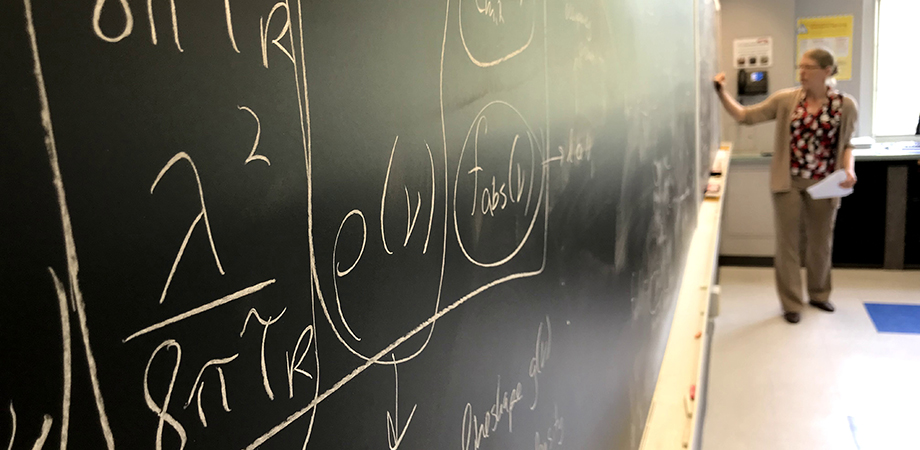Day in the Life of an SPIE Professional: Amy Oldenburg

SPIE Fellow Dr. Amy Oldenburg started the Optical Coherence Imaging Laboratory at UNC Chapel Hill in 2008. Her research focuses on the use of coherent optical and acoustic properties for imaging tissue viscoelastic properties, and developing novel contrast mechanisms for biomedicine.
Describe a typical recent day at the office.
In my vintage Miata, I enjoy the route to Chapel Hill, with wisteria, cherry, and redbud in full bloom. Climbing hills and stairs to my office, I first catch up with email: one student is finalizing a journal paper; another student has sent me his preliminary exam paper for review. I organize some laboratory tours, and plan a meeting to work on an FDA investigational device-exemption application for our airway endoscopy instrument. Then comes grading and preparing a lecture for my optics course: today's topic is an introduction to semiconductor optics. I adopt a strategy of making analogies between the rate equations for emission and absorption in semiconductors to those for two-state systems, a topic that we studied the previous week. I head upstairs to my laboratories, catching up with students' different projects: optical imaging of nasal cavities, ultrasound imaging of thrombosis, and optical detection of biological magneto-receptors. In the afternoon, I present the optics lecture. Finally, I meet with my most senior graduate student to go over her latest results in measuring airway wall compliance after burn injury. There are some very good results, as well as some problems. We brainstorm about how to troubleshoot the problems, and go over what she will present in her thesis and final exam.
What are three skills necessary to do your job?
First, communication skills, particularly writing. Managing a laboratory requires you to be an effective communicator on a daily basis. And the ability to communicate your research in publications and grant proposals is crucial. Next, the ability to analyze a complex problem—for example, understanding at a fundamental level all of the dependencies that affect the signals you are measuring in an experiment—is key. These skills are a baseline before you can develop a good sense for how to troubleshoot problems, or the ability to recognize something new and exciting hidden in your data. Finally, grit and determination! This includes being able to work in an area outside of your expertise. It also means being undaunted by boring or repetitive tasks that make up the lion's share of academic work. As I like to say, if it's not boring and repetitive, you haven't "gotten it down to a science" just yet.
What is the most interesting challenge you've worked on recently?
While I hate to play favorites with the research projects in my lab, the most interesting one currently is my student's project on developing a parallel-plate rheometer that can be accessed by optical coherence tomography for real-time imaging of shear within the bulk of the fluid. There is a lot of rich theory in describing viscoelastic materials—including wave propagation and particle diffusion—that I enjoy learning about. The challenge is to try to best adapt the device to extract meaningful materials properties, within a range that is of biological interest for fluids such as mucus.
How did you end up working in academia?
I enjoyed math early, gravitated (pun intended) toward physics in high school, and, as an applied physics major at Caltech, took an elective in optical electronics that interested me in lasers and optics. When I knew I wanted to pursue a PhD in optical physics, I joined an atomic, molecular, and optical (AMO) physics lab at the University of Illinois at Urbana-Champaign. Toward graduation, I explored job opportunities at Intel to work on excimer lasers, and at GE as a scientist. But there was a postdoc opening at Illinois doing biomedical optical imaging with a relatively new professor, Dr. Stephen Boppart. I knew nothing about biomedicine, but the position primarily required knowledge of a particular type of mode-locked laser I had worked with in the AMO lab, so I jumped on it. I enjoyed being a postdoc for many years, and was promoted to senior research scientist. Although I hadn't been looking for faculty positions, I learned of a position at UNC-Chapel Hill in Physics and Astronomy, with a co-appointment in the Biomedical Research Imaging Center. I recall looking at the ad and getting excited about how perfectly it matched my background and interests. Serendipity! I see my career as an evolving story: my lab at UNC Chapel Hill has reached its peak size, and my interests are increasingly geared toward translating our technologies into commercialized devices and applications that can impact human health.
How do you balance your research, teaching, and publishing obligations?
As a lab director, I would certainly add proposal writing to this list! The research cannot happen without funds coming in, so that's a priority. There is absolutely no way to keep on top of everything when running a large research group. My favorite analogy is my experience as a kid at camp: there was this big, muddy hill that we would slide down on the seat of our pants. Once you started, there was no way to stop, but you could guide your direction by leaning one way or the other. You just have to accept the speed with which things come at you, and make the best of it.

Dr. Amy Oldenburg in her lab at University of North Carolina Chapel Hill.
| Enjoy this article? Get similar news in your inbox |
|



